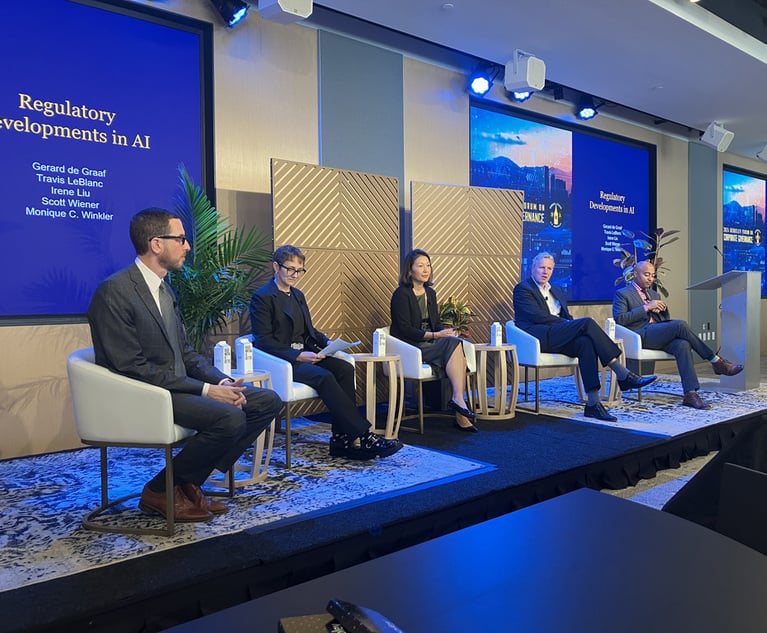What Steps Should Covered Entities, Business Associates Take to Combat Cyberthreats?
Over the last several months there has been an onslaught of news about cyberattacks, most notably ransomware attacks involving many industries, including…
July 24, 2017 at 09:16 AM
8 minute read
The original version of this story was published on Law.com
Over the last several months there has been an onslaught of news about cyberattacks, most notably ransomware attacks involving many industries, including health care institutions both in the United States and abroad, most notably the “WannaCry” attack. Most recently, a new ransomware attack known as “Petya” made headlines. By all accounts, these attacks are predicted to get worse. These attacks are in addition to other cybersecurity issues involving identity theft and other types of hacking.
Data loss through cybercrime creates an ever-increasing risk, especially to the health care industry, which is becoming a targeted industry. As discussed below, education and prevention are keys to protecting sensitive health care data and quickly responding to a security incident. The federal government through the Department of Health and Human Services (HHS) and the Office of Civil Rights (OCR) websites provide summaries of the HIPAA Privacy, Security and Breach Notification Rules. Understanding and complying with these various HIPAA requirements, including the requirements in the privacy rule that covered entities have a business associate agreement with its vendors that have access to personal health information (PHI), are the first steps to be taken to protect sensitive health care data. The security rule sets the standards to control the confidentiality and storage of electronic PHI, and access to electronic PHI.
The OCR continues to provide guidance on the issues of cybersecurity in the form of summary bulletins. In February 2017, it issued one titled “Reporting and Monitoring Cyberthreats.” In May 2017, it issued a summary bulletin titled “Cybersecurity Incidents Will Happen … Remember to Plan, Respond and Report.” In that summary, the OCR listed the following incident headlines:
This content has been archived. It is available through our partners, LexisNexis® and Bloomberg Law.
To view this content, please continue to their sites.
Not a Lexis Subscriber?
Subscribe Now
Not a Bloomberg Law Subscriber?
Subscribe Now
NOT FOR REPRINT
© 2025 ALM Global, LLC, All Rights Reserved. Request academic re-use from www.copyright.com. All other uses, submit a request to [email protected]. For more information visit Asset & Logo Licensing.
You Might Like
View All
Fatal Shooting of CEO Sets Off Scramble to Reassess Executive Security
5 minute read
Ben & Jerry’s Accuses Corporate Parent of ‘Silencing’ Support for Palestinian Rights
3 minute read
Shareholder Activists Poised to Pounce in 2025. Is Your Board Ready?

Regulatory Upheaval Is Coming. How Businesses Prepare and Respond Will Separate Winners and Losers
Trending Stories
- 1Tensions Run High at Final Hearing Before Manhattan Congestion Pricing Takes Effect
- 2Improper Removal to Fed. Court Leads to $100K Bill for Blue Cross Blue Shield
- 3Michael Halpern, Beloved Key West Attorney, Dies at 72
- 4Burr & Forman, Smith Gambrell & Russell Promote More to Partner This Year
- 5Sanctions Order Over Toyota's Failure to Provide English Translations of Documents Vacated by Appeals Court
Who Got The Work
Michael G. Bongiorno, Andrew Scott Dulberg and Elizabeth E. Driscoll from Wilmer Cutler Pickering Hale and Dorr have stepped in to represent Symbotic Inc., an A.I.-enabled technology platform that focuses on increasing supply chain efficiency, and other defendants in a pending shareholder derivative lawsuit. The case, filed Oct. 2 in Massachusetts District Court by the Brown Law Firm on behalf of Stephen Austen, accuses certain officers and directors of misleading investors in regard to Symbotic's potential for margin growth by failing to disclose that the company was not equipped to timely deploy its systems or manage expenses through project delays. The case, assigned to U.S. District Judge Nathaniel M. Gorton, is 1:24-cv-12522, Austen v. Cohen et al.
Who Got The Work
Edmund Polubinski and Marie Killmond of Davis Polk & Wardwell have entered appearances for data platform software development company MongoDB and other defendants in a pending shareholder derivative lawsuit. The action, filed Oct. 7 in New York Southern District Court by the Brown Law Firm, accuses the company's directors and/or officers of falsely expressing confidence in the company’s restructuring of its sales incentive plan and downplaying the severity of decreases in its upfront commitments. The case is 1:24-cv-07594, Roy v. Ittycheria et al.
Who Got The Work
Amy O. Bruchs and Kurt F. Ellison of Michael Best & Friedrich have entered appearances for Epic Systems Corp. in a pending employment discrimination lawsuit. The suit was filed Sept. 7 in Wisconsin Western District Court by Levine Eisberner LLC and Siri & Glimstad on behalf of a project manager who claims that he was wrongfully terminated after applying for a religious exemption to the defendant's COVID-19 vaccine mandate. The case, assigned to U.S. Magistrate Judge Anita Marie Boor, is 3:24-cv-00630, Secker, Nathan v. Epic Systems Corporation.
Who Got The Work
David X. Sullivan, Thomas J. Finn and Gregory A. Hall from McCarter & English have entered appearances for Sunrun Installation Services in a pending civil rights lawsuit. The complaint was filed Sept. 4 in Connecticut District Court by attorney Robert M. Berke on behalf of former employee George Edward Steins, who was arrested and charged with employing an unregistered home improvement salesperson. The complaint alleges that had Sunrun informed the Connecticut Department of Consumer Protection that the plaintiff's employment had ended in 2017 and that he no longer held Sunrun's home improvement contractor license, he would not have been hit with charges, which were dismissed in May 2024. The case, assigned to U.S. District Judge Jeffrey A. Meyer, is 3:24-cv-01423, Steins v. Sunrun, Inc. et al.
Who Got The Work
Greenberg Traurig shareholder Joshua L. Raskin has entered an appearance for boohoo.com UK Ltd. in a pending patent infringement lawsuit. The suit, filed Sept. 3 in Texas Eastern District Court by Rozier Hardt McDonough on behalf of Alto Dynamics, asserts five patents related to an online shopping platform. The case, assigned to U.S. District Judge Rodney Gilstrap, is 2:24-cv-00719, Alto Dynamics, LLC v. boohoo.com UK Limited.
Featured Firms
Law Offices of Gary Martin Hays & Associates, P.C.
(470) 294-1674
Law Offices of Mark E. Salomone
(857) 444-6468
Smith & Hassler
(713) 739-1250






